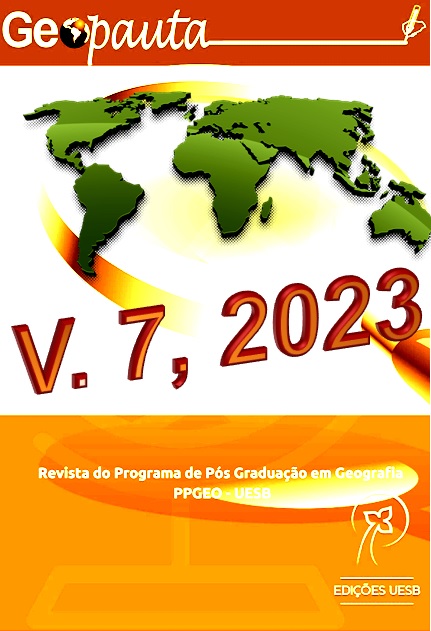The fragmentation on the side of the road: the spatial practices of residents of gated communities
DOI:
https://doi.org/10.22481/rg.v7.e2023.e11606Keywords:
self-segregation, socio-espatial fragmentacion, espatial pratices, fobópole, road safetyAbstract
In modernity, the insecurities of life in the metropolis trigger strategies of self-segregation in gated community. Thus, the general objective of this research is to investigate the spatial practices of residents of gated communities in the metropolitan area of Brasília. The specific objectives are to identify the factors that lead to the consumption of housing units in these spaces and to analyze the spatial practices of these residents. Through bibliographic research and application of questionnaires, it was observed that controlling access to collective housing space is the main factor for the consumption of these autonomous units, the metropolis is experienced as a unique region and the feeling of security provided by living in a gated community contrasts with road insecurity.
Downloads
Metrics
References
BAUMAN, Z. Modernidade líquida. Rio de Janeiro. Editora Zahar, 2011. Edição Digital.
BAUMAN, Z. Confiança e medo na cidade. Rio de Janeiro. Editora Zahar, 2012. Edição Digital.
BAUMAN, Z; LYON, D. Vigilância líquida. Rio de Janeiro. Editora Zahar, 2013. Edição Digital.
CALDEIRA, T. P. do R. Cidade de muros. Crime, segregação e cidadania em São Paulo. São Paulo: EDUSP; 2000.
CORREA, R. L. Segregação residencial: classes sociais e espaço urbano. In VASCONCELOS, P. de A.; CORREA, R. L.; PINTAUDI, S. M. (Orgs.). A cidade contemporânea. Segregação espacial. São Paulo. Editora Contexto, 2018. p. 39-59.
DOURADO, J.; SOBRINHO, F. L. A. O processo de periferização da habitação financiado pelo Programa Minha Casa Minha Vida. Sociedade e Natureza, Uberlândia, MG. v. 32, 2020A. p.740-751. https://doi.org/10.14393/SN-v32-2020-54948
DOURADO, J.; SOBRINHO, F. L. A. Entre a forma e o produtor do edifício. O processo de verticalização urbana em Valparaíso de Goiás, Brasil. Terr@ Plural, Ponta Grossa, PR. v. 14, 2020B. p. 1-20. DOI: 10.5212/TerraPlural.v.14.2013203.023
DOURADO, J.; SOBRINHO. A fragmentação socioespacial na metropolização: entre condomínios, loteamentos fechados e de acesso controlado na Área Metropolitana de Brasília Sul. Cerrados, Montes Claros, MG. v. 20, 2022. p. 313-346. DOI: 10.46551/rc2448269220221
GIL, A. C. Métodos e técnicas de pesquisa social. São Paulo: Atlas, 2008, 200 p.
GÓES, E. M.; SPOSITO, M. E. B. Práticas espaciais, cotidiano e espaço público: o consumo como eixo da análise do calçadão de Presidente Prudente-SP. Revista da Associação Nacional de Pós-graduação e Pesquisa em Geografia (Anpege). p.39-65, V.12, n.19, 2016. https://doi.org/10.5418/RA2016.1219.0002
GRAHAM, S. Cidades sitiadas. O novo urbanismo militar. São Paulo. Editora Boitempo, 2016. Versão digital.
GUNTHER, H. Como elaborar um questionário. Planejamento de Pesquisa nas Ciências Sociais, Nº 1. Brasília: UnB, Laboratório de Psicologia Ambiental, 2003.
LENCIONI, S. Metrópole, Metropolização e Regionalização. Rio de Janeiro: Editora Consequência; 2017.
MOURA, R.; BRANCO, M. L. G. C.; FIRKOWSKI, O. L. C. de F. Movimento pendular e perspectivas de pesquisas em aglomerados urbanos. São Paulo em perspectiva, v. 19, n. 4, p. 121-133, 2005.
SODRÉ, R. Prática espacial, habitus e espaço urbano: ensaio de geografia da vida cotidiana. Geopauta, Vitória da Conquista, ISSN: 2594-5033, V. 5, n. 1, 2021. https://doi.org/10.22481/rg.v5i1.7287
SOUZA, M. L. de. Fobópole. O medo generalizado e a militarização da questão urbana. Rio de Janeiro. Bertrand Brasil, 2008. 288 p.
SOUZA, M L. de. Os conceitos fundamentais da pesquisa sócio-espacial. Rio de Janeiro. Bertrand Brasil, 2013. 320 p.
SPOSITO, M. E. B.; GÓES, E. M. Espaços fechados e cidades. Insegurança urbana e fragmentação socioespacial. São Paulo. Unesp, 1ª Edição, 2013. 359 p.
SPOSITO, M. E. B. Práticas espaciais e reestruturação em cidades médias. Consumo e cotidiano. In FERREIRA, A; RUA, J.; MATTOS, R. C. (Orgs). O espaço e a metropolização. Cotidiano e ação. Rio de Janeiro. Editora Consequência. 2017. P. 627-677.
SPOSITO, M. E. B. Segregação socioespacial e centralidade urbana. In VASCONCELOS, P. de A.; CORREA, R. L.; PINTAUDI, S. M. (Orgs.) A cidade contemporânea. Segregação espacial. São Paulo. Editora Contexto, 2018. p. 61-93.
SPOSITO, E. S.; SPOSITO, M. E. B. Fragmentação socioespacial. Mercator, Fortaleza, ISSN:1984-2201, v.19, 2020. https://doi.org/10.4215/rm2020.e19015
SWISS PARK, Incorporadora. Disponível em [https://swisspark.com.br/] acessado em fevereiro de 2021.
VASCONCELOS, P. de A. Contribuição para o debate sobre processos e formas socioespaciais nas cidades. In VASCONCELOS, P. de A.; CORREA, R. L.; PINTAUDI, S. M. (Orgs.). A cidade contemporânea. Segregação espacial. São Paulo. Editora Contexto, 2018. p. 17-37.
VILLAÇA, F. Espaço intra-urbano no Brasil. Studio Nobel. São Paulo. 2ª edição. 2017. 391 p.
Downloads
Published
How to Cite
Issue
Section
License
Copyright (c) 2023 from the Geopauta Journal and the Author(s)

This work is licensed under a Creative Commons Attribution 4.0 International License.
Copyright
Authors must retain unrestricted copyright and grant the Geopauta the first publication with the work simultaneously licensed under CC BY which allows others to share with recognition of each author's authorship in the initial publication in this Journal
Intellectual Property and Terms of Use
Geopauta adopts the Free Access policy in accordance with Open Access - OAC recommended by DOAJ and in accordance with the SciELO Criteria, under a Creative Commons CC By Attribution 4.0 International License, allowing immediate free access to the work and allowing any user to read, download, copy, distribute, print, search or link to the full texts of the articles, track them for indexing, pass them as data to software or use them for any other legal purpose.
Geopauta attributes the CC BY. license. where it is allowed without restrictions:
Share — copy and redistribute the material in any medium or format for any purpose, even commercial. as long as they give due credit for the original creation.
Adapt — remix, transform, and create from the material for any purpose, even commercial purposes, as long as due credit is given for the original creation.












